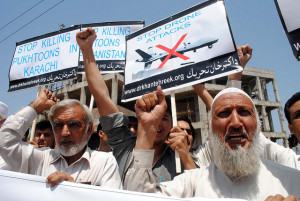By Paul Mutter
In what is hopefully a wake-up call for US news media, the New York Time’s public editor, Margaret Sullivan, casts a critical eye on the vagueness of the information the paper provides on drone strikes:
Some of the most important reporting on drone strikes has been done at The Times, particularly the “kill list” article by Scott Shane and Jo Becker last May. Those stories, based on administration leaks, detailed President Obama’s personal role in approving whom drones should set out to kill.
Groundbreaking as that article was, it left a host of unanswered questions. The Times and the American Civil Liberties Union have filed Freedom of Information requests to learn more about the drone program, so far in vain. The Times and the A.C.L.U. also want to know more about the drone killing of an American teenager in Yemen, Abdulrahman al-Awlaki, also shrouded in secrecy.
But The Times has not been without fault. Since the article in May, its reporting has not aggressively challenged the administration’s description of those killed as “militants” — itself an undefined term. And it has been criticized for giving administration officials the cover of anonymity when they suggest that critics of drones are terrorist sympathizers.
Americans, according to polls, have a positive view of drones, but critics say that’s because the news media have not informed them well. The use of drones is deepening the resentment of the United States in volatile parts of the world and potentially undermining fragile democracies, said Naureen Shah, who directs the Human Rights Clinic at Columbia University’s law school.
“It’s portrayed as picking off the bad guys from a plane,” she said. “But it’s actually surveilling entire communities, locating behavior that might be suspicious and striking groups of unknown individuals based on video data that may or may not be corroborated by eyeballing it on the ground.”





Drone killing, as described (But it’s actually surveilling entire communities, locating behavior that might be suspicious and striking groups of unknown individuals based on video data that may or may not be corroborated by eyeballing it on the ground) is killing based on a form of “pattern recognition” that may be as poor (or worse) than eye-witness identifications following one sighting of a criminal, briefly, in a dark room.
Few would rationally credit such “pattern recognition” as a valid method for recognizing persons intending to do harm to Americans-in-America or American forces where scattered around the world. after all, the remote mountains of Pakistan and Yemen are not places where people can assemble before doing “imminent harm” to Americans.
It’s not far from a policeman (let’s say in plain clothes) pulling his gun and firing repeatedly and murderously into a crowd — and explaining, well, I saw someone in there who looked like a criminal to me.
We wouldn’t permit it at home and we should not permit it anywhere. If anyone did it to us we’d call it terrorism.